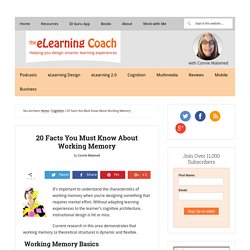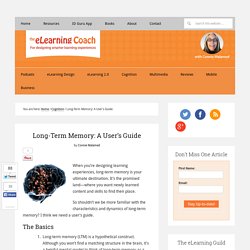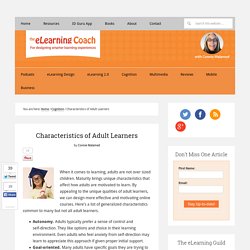

20 Facts You Must Know About Working Memory. It’s important to understand the characteristics of working memory when you’re designing something that requires mental effort.

Without adapting learning experiences to the learner’s cognitive architecture, instructional design is hit or miss. Current research in this area demonstrates that working memory (a theoretical structure) is dynamic and flexible. Working Memory Basics Working memory used to be called short-term memory. It was redefined to focus on its functionality rather than its duration. Debunking The Study, Study, Study Myth. Sharebar Some people think that ramming information into their brain over and over again is the best way to learn it.

That’s the equivalent of hitting your head with a hammer. Studying the same information over and over again has its limits. Newer research shows that the missing ingredient to many study routines is practice with retrieval (Karpicke, 2012). What is retrieval? Retrieval is the process of recovering knowledge and information from long-term memory, where it was encoded for just such a purpose.
Importance of the Retrieval Cue Retrieval cues are important because they are the key that unlocks the information. Is it really that simple? Actually, no. How Retrieval Enhances Learning and Retention A memory is reconstructed in the moment, depending on interactions of context, retrieval cues, and memory processes themselves. It is this very act of reconstruction that makes retrieval so important.
The Little Known Formula for Long-term Retention Retrieval-based Learning in the Workplace. What is cognitive load? As far as I can tell, working memory (WM), the part of our brain that consciously processes information, dominates everything we do in terms of learning. Working memory can only hold 4-5 bits of information at one time and information in working memory lasts only around ten seconds. The fact that our working memories have a small capacity and a short duration is worthy of headline news.
It’s what we’re up against as humans and as learning experience designers. Interactions Between WM and LTM Unlike working memory, long-term memory appears to have an unlimited capacity. The interaction goes both ways. WM is Vulnerable to Overload Sometimes learning involves great effort—even suffering (am I a drama queen?). What causes too much demand on working memory? The Good, the Bad and the Ugly. Long-Term Memory: A User’s Guide. Ms.

Malamed, I recently started my journey in obtaining my Masters degree in Instructional Design and Technology. While I have known there are blogs out there I have recently started following blogs to help further my knowledge of IDT. This week in our class we are focusing on learning processing and that “all learning involves forming associations between stimuli and responses” (Ormrod, Schunk, & Gredler, 2009, p.49). Your “User’s Guide to Long Term Memory” has helped me to understand this better.
Until now I did not realize there were so many different types of memory. Up until know I feel I have been naïve in regards to memory. I’m looking forward to more great articles in the future! Heather References: Ormrod, J., Schunk, D., & Gredler, M. (2009). Metacognition And Learning: Strategies For Instructional Design. Do you know how to learn?

Many people don’t. Specifically, they don’t know how to look inward to examine how they learn and to judge which methods are effective. That’s where metacognitive strategies come in. They are techniques that help people become more successful learners. Shouldn’t this be a crucial goal of instructional design? Improved metacognition can facilitate both formal and informal learning. But let’s start at the beginning. What is metacognition? Metacognition is often referred to as “thinking about thinking.” The Two Processes of Metacognition Many theorists organize the skills of metacognition into two complementary processes that make it easier to understand and remember.
Metacognition and Expertise Many experts cannot explain the skills they use to elicit expert performance. Examples of Metacognition Skills You May Use Successful learners typically use metacognitive strategies whenever they learn. Characteristics of Adult Learners. SumoMe When it comes to learning, adults are not over sized children.

Maturity brings unique characteristics that affect how adults are motivated to learn. By appealing to the unique qualities of adult learners, we can design more effective and motivating online courses. Here’s a list of generalized characteristics common to many but not all adult learners. Autonomy. What other characteristics of adult learners can you add this to list? Cognition.